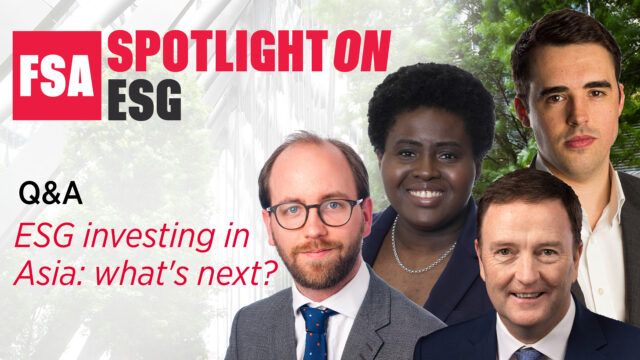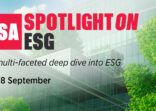What are the key trends (in terms of markets and asset classes) that will shape ESG-related investments over the next 6 months?

Noel: In terms of topics that investors are likely to focus on, climate change is likely to continue to be the single most important topic, particularly following the release of the most recent Assessment Report from the Intergovernmental Panel on Climate Change, which issued the now-famous “code red for humanity” call for urgent action. We at KBI Global Investors agree, and have recently joined the Net Zero Asset Managers Initiative, committing to achieving Net Zero in our investment portfolios.
Beyond climate change, the emerging topics of most interest to investors may well be biodiversity & the circular economy.
Investors know that rapidly declining biodiversity is an urgent problem, but they are not yet sure how they can mobilise capital to help to provide solutions (or benefit from opportunities). Work by the Taskforce on Nature-related Financial Disclosures initiative may be very helpful in that regard, as it aims to develop a framework similar to the TCFD framework for climate change.
Circularity within the global economy is gaining traction as a topic for investors. Transformative innovation, including digitization, has wide application in the broad economy and will be a key enabler of the shift to an economy that is circular and regenerative in nature.

Will: It seems like the trend in Asia is towards thematic strategies and particularly low carbon themes, perhaps because some of the effects of pollution are so much more visible and thus relatable. My instinct is that this space is set to become more congested and competed for. As a result, over this coming period we will all have to be more transparent and explicit as to how ESG matters are truly informing investment decisions and, perhaps most importantly, what real-world impact we are making as a result. The authenticity test if you like.

Amarachi: A key trend is the drive towards net zero carbon. We are seeing this not just in Asia, but across markets because this is a global issue. The Intergovernmental Panel on Climate Change (IPCC) has released the first instalment of their sixth assessment report on the climate, and they were quite blunt in emphasising the urgent need for action, otherwise we risk some of the most catastrophic, life changing weather and climatic events. We are already seeing this and if care isn’t taken, it will eventually become a norm. In the span of one month, we’ve seen the consequences of extreme weather in places like Hubei province in China and in Singapore, where I understand from my colleagues there just experienced unusually intense floods. It could be Hubei and Singapore today, and anywhere tomorrow. We can expect to see this being addressed in terms of investment trends, where some of the investments will be in climate mitigation solutions and some will be in climate change adaptation.
One prominent ESG investment trend is the internet of things which has gained traction in the Asian market over the past few years as the move to digitalisation took shape. I don’t think we expect that to change in the next 6 months. Meanwhile, we expect healthcare to also be a key theme, especially as COVID continues to loom over us. The virus does not look to be going anywhere; what’s going to end up happening is we are going to have to find ways to manage the virus, and that will be an investible trend in the coming 6 months.

Harry: China’s regulatory agenda will shape ESG-related investments in Asia over the next 6 months. So far in 2021, we have seen the Chinese education sector become un-investable, starting with the regulator’s rebuke in May that the sector’s malpractices had damaged the legitimate rights and interests of students and disrupted orderly market competition, and ending with the decree in July that the sector should not be run for profit. This has been a stark lesson that proliferating non-financial risks can result in an entire sector losing its social license-to-operate.
What opportunities does the ‘greening’ of Asia’s markets via net zero commitments present for investors?

Noel: For more than two decades we have been investing in companies that provide solutions to the global shortage of clean energy, so we are of course very excited about the increased opportunities that we now see for that type of investment, as so many companies (and governments) focus on achieving Net Zero by the middle of this century at the latest. That should mean a wave of investment in, for example, clean energy providers (wind, solar etc) and in products and services that help companies and individuals to reduce or eliminate their carbon emissions.

Will: The increasing commitments to net zero are welcome, however, the commitments in of themselves can mean little. August’s IPCC report makes clear that immediate carbon emissions reductions are needed. The opportunity therefore, especially for engaged investors, comes via the increased attention and in turn scrutiny that is now being given to what these commitments mean in practice. Capital markets will ultimately reward those who are committed to walking the talk – and perhaps turning that walk into a sprint.

Amarachi: It presents massive opportunities. What we have seen in the Asian markets is the willingness to act quickly upon certain ESG and greening trends, and a general willingness for industrial development, but in a cleaner way than it’s been done in the West. We are seeing this in Singapore, Taiwan and Vietnam. For us, that’s presented good opportunities to invest in companies that are on the path of growth but are doing it in a way that is far more sustainable than how we had looked to do it in the West.

Harry: 2020 was undoubtedly the year that environmental investing came of age. Partly in response to the global pandemic, governments around the world announced truly vast support packages worth trillions of dollars to help facilitate the green transition. Moreover, the recent publication of the UN IPCC’s Sixth Assessment report forecasts that the world will likely temporarily reach +1.5C of warming within 20 years even in a best-case scenario of deep cuts in greenhouse gas emissions. Therefore, in addition to the existing fiscal commitments made by leading governments across the globe, the timeline moving up to 2040 will demand ever more and a number of Asia’s key economies have now made substantial net-zero commitments.
Crucially from an investment perspective, we believe that this will provide a persistent tailwind to environmental equities, which in our view represents the biggest structural growth opportunity of the next generation. We believe that environmental equities are incredibly exciting because they offer an opportunity to invest in companies that can grow and compound revenues at very high rates for a prolonged period of time. There are many areas within this thematic that we believe will be 10 times bigger in 10 years’ time, including electric vehicles, solar and wind power, but there are also areas that could realistically be 100 times or even 1000 times bigger, including carbon capture, hydrogen, lab cultured meats and recycled clothing. In our view, investing in these disruptive, high-growth industries with huge addressable markets offers an unparalleled opportunity to generate substantial long-term returns.
Indeed, many of the most exciting environmental technologies are being developed in North Asia, particularly in China, Korea and Taiwan. China aims to reach peak emissions before 2030 and achieve carbon neutrality before 2060, requiring a two-thirds reduction in emissions intensity versus 2005 levels. MSCI estimates that this will require MSCI China index constituents to cut 1.4 billion tonnes of CO2e by 2030, or 28% of the portfolio’s estimated carbon emissions – materials and utilities will have to achieve the largest absolute emission reductions and thus national champions in these sectors will likely play a leadership role in decarbonisation. Furthermore, the Chinese government’s latest Five Year Plan has doubled-down on these efforts, precipitating a significant acceleration in the build-out of renewables infrastructure. This is despite the fact that the global renewables value chain already consistently leads back to China. For example, in a typical solar panel, it is highly likely that the polysilicon, the glass, the module and the cell will all have been manufactured in China.
Korea is also at the forefront of many green technologies, particularly those related to transportation. 60% of the world’s batteries are currently made in Korea, which means that much of the battery materials supply chain is also being localised in the country. The Korean government has mandated a big push in hydrogen technologies and has set an ambitious target of building out 8 gigawatts of domestic hydrogen fuel cell capacity. Taiwan meanwhile, by virtue of its leading expertise in the semiconductor and electronics industries, is a key beneficiary of the electrification of the planet. If you were to distil the green transition into its simplest form, it is essentially a shift from hydrocarbon molecules – coal, gas and oil – to electrons. Taiwan is home to numerous companies in the supply chains for the electrification of homes and vehicles. As such, its economy is one of the most geared to the accelerating shift towards electrification.
The IPCC report also highlights the urgent need for adaptation. We continue to see physical climate risks materialise at an accelerating pace globally, as well as in Asia. After years of sporadic droughts and water scarcity, Southeast Asia experienced massive flooding and large-scale crop damage in recent years, whilst there have been water shortages in Taiwan. Companies will need to provision for supply chain disruptions in Southeast Asia, which is likely to experience catastrophic cyclonic events. In addition to investment opportunities in companies that are facilitating the transition towards a lower-carbon world, we are also explicitly looking to channel capital towards companies protecting against ecosystem destruction. Indeed, our investments in areas such as responsible consumption and the circular economy aim to address issues such as waste and the excessive use of raw materials, which are contributing to ecosystem destruction and biodiversity loss.
Implementing ESG factors is often easier said than done. How can investors effectively integrate sustainability in their processes to have the desired impact?

Noel: Integrating ESG into investment processes is a challenge, of course, but not a particularly difficult one for investment managers. Many investment managers, including KBI GI, have been doing this for many years, so this is no longer something new or experimental. At its core, it is no more and no less than examining the ESG performance of companies in much the same way as investors already examine the financial performance of companies, or the quality of its management. That can be done by the portfolio manager or by using external expertise. If it is the portfolio manager doing the research on the ESG performance of a company, they will no doubt need some technical training in aspects of ESG such as how to assess the carbon footprint of a company, or best practices in supply chain monitoring for human rights abuses such as the use of forced labour. But these are skills that are relatively easy to acquire and which are, in my view, going to be essential for every investment professional in the near future.

Will: In this respect, as in others, I believe it is better to not over-claim. ESG integration, as with many other aspects of investment decision making, is more art than science. In my view the effectiveness is less about the explicit process and more about the thought process. We make a significant effort to consider ESG both in the sense of what a business does and how it does it. Ultimately, as long-term investors we want to invest in businesses that ‘get it’ and are positioning themselves for tomorrow, today. That is of course easier said than done, but no investment decision is ever straight forward.

Amarachi: It has never been easy to integrate ESG factors, not just in investments, but across the board. One of the things that investors can do to start off is to be focussed and decide which factors are the most important to them. The reality is that sustainability contains many elements, and it will be tough for any fund to cover all factors. Picking what is important to you and having a focus is a good start. We have done that with our sustainable investing with our 10 sustainable development themes. Through that, we picked 5 environmental and 5 social themes that are important to us. Investors should also ask questions. The reality is there isn’t a consistent approach to ESG and sustainability. Greenwashing is real not just in this industry, and often, the way to get around greenwashing is to ask questions and get clarity. Another thing to highlight it to look for transparency. This is particularly important in the Asian market. The Asian market is growing and can start from a clean slate. There’s so much innovation in Asia compared to other markets, that there’s the potential to create solutions that’s not been thought of before.

Harry: Successfully integrating ESG factors requires the ability to make the link between ESG factors and alpha generation, and ESG factors do not always have highly statistically significant correlations with returns. However, companies with strong ESG practices are more likely to avoid hidden ESG risks and associated liabilities, which continue to grow each year.Investors can look to invest in companies that provide solutions to environmental or social problems, as this is a clear way of having the desired impact. Furthermore, in our view the environmental thematic represents the biggest structural growth opportunity of the next generation.
The Fund Selector Asia Spotlight On: ESG will run on 13 – 16 Sept and ends with a LIVE event (on the 16th) where we will bring together a panel of fund selectors and the fund managers to discuss their views and join an interactive Q&A session.
Find out more about our Spotlight On: ESG here: https://fundselectorasia.com/spotlight-on/esg/

















